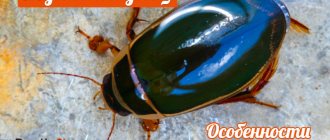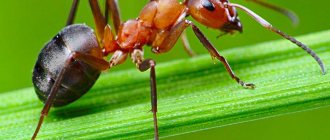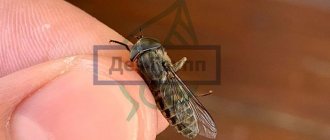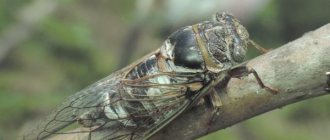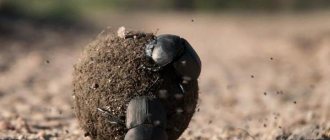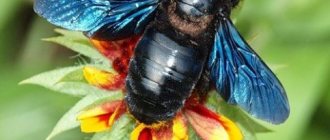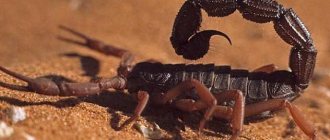Description
Ground beetles are large (usually around 15 mm long) individuals, with individual specimens reaching an incredible five cm in length - if not more.
The body of this beetle is usually elongated, with various variations of shades from dark black to brown, even sometimes with a metallic or pearlescent tint. The wings of these beetle species are typically grooved and decorated with brightly colored tiny dots.
Given their size, it is not surprising that these insects do not fly very well (and some of them cannot do it at all!) - they mainly use flights exclusively for settlement.
The ground beetle family is diverse in size - from a couple of millimeters to ten centimeters and has a wide variety of colors.
Characteristic features of this family are strong legs, bulging eyes and an unusual mouthparts equipped with powerful mandibles.
Phylogeny
Phylogenetic tree of the ground beetle family (after DR Maddison et al., 1999)
Ground beetles are closely related to the trachypachidae family (Trachypachidae CG Thomson, 1857), with which they have common ancestors. Regarding the intrafamily relationships of ground beetles, there are significant differences between different scientists and scientific schools, which is also reflected in the taxonomy of the family. The study of phylogenetic relationships using 18S ribosomal DNA sequencing methodology shows some nuances of the relationship of different groups of ground beetles. According to research, the oldest branches of the family are the subfamilies Carabinae and Siagoninae, which are located separately from other groups. From a common ancestor comes a group of subfamilies: Nebriinae, Loricerinae, Omophroninae, Psydrinae, Promecognathinae and Apotominae. The subfamily of bighead ground beetles (Broscinae) is close to them, however, it is located somewhat apart and is more evolutionarily developed. A separate group consists of the subfamilies Patrobinae and Trechinae, which are relatively young and developed from a common ancestor. The most specialized and evolutionarily developed of these is the scarita subfamily (Scaritinae). A completely different group of the family consists of the most evolutionarily progressive subfamilies of psidrins (Psydrinae), brachininae (Brachininae) and harpalinae (Harpalinae), and psidrins are much more isolated from the last two.
Big-headed ground beetle
Types of ground beetles
Ground beetles are distinguished by their extraordinary size, including being one of the largest families, which includes many genera and species, the classification of which is quite difficult.
Therefore, usually many features are used to diagnose and classify the species of these insects - from color and shape of the structure, structure, and even chaetotaxy (arrangement of bristles).
For example, the fauna of our country includes 15 subfamilies of this family, which, in turn, are divided into 40 tribes, almost 200 genera and almost 2 thousand species - and this accounts for about 5% of the entire world fauna of these insects.
Such a huge number of species and insects are usually divided into three large groups:
- Phytophagous
This small part is engaged in the destruction of cultivated plants - and significantly complicates the management of agricultural farming (including private ones). Usually in this case we are talking about a species such as the grain ground beetle - a resin-colored beetle of large size - about 1.5 cm. These beetles feed on cereal grains - wheat, barley and many other cultivated plants.
Bread ground beetle
- Entomophages
This is a useful ground beetle, but also a formidable predator. It benefits by eating many harmful insects that cause damage to agriculture.
- Mixophages (for example, millet ground beetle).
The beetles included in this group eat mainly plant foods, but sometimes they also happily consume food of animal origin when the diet is still significantly limited.
The system of ground beetle forms includes a separate classification in connection with the type of food, as well as depending on the habitat layer and even the type of movement.
Millet ground beetle
Other examples of ground beetles that we wrote about earlier
Caucasian ground beetle
Hungarian ground beetle
Gebler's ground beetle
Further reading[edit]
- Insect portal
- Arthropod portal
- E. Chiki (1946). Die Käferfauna des Karpaten-Beckens
[
The beetle fauna of the Carpart Basin
] (in German). Budapest. pp. 71–546. - K. Cult (1947). Klíč k určování brouků čeledi Carabidae Československé republiky
[
Key to the beetles of the family Carabidae of the Czech Republic
] (in Czech). Prague. - C. H. Lindroth (1942). Coleoptera, Carabidae
. Svensk Insectenfauna, Vol. 9 (in Swedish). Stockholm. pp. 1–260. - Edmund Reuter (1908–1917). Die Käfer des Deutschen Reiches
[
Beetles of the German Empire
] (in German). Stuttgart: KG Lutz.
Red Book
Ground beetles are one of the numerous families (if not the largest), the number of species of which ranges from 50 thousand species, which are replenished annually. And some of them are listed in the Red Book - such as, for example, the Crimean ground beetle. Its number is directly related to the amount of precipitation - it is they that regulate the volume of the food supply of this insect, which includes terrestrial mollusks. Its numbers are declining due to a decrease in areas of virgin soil, as well as an increase in the use of pesticides.
Crimean ground beetle
Nutrition
Ground beetles (the vast majority of them) are predators whose diet consists of a wide variety of invertebrate species. And in the evening they begin to hunt caterpillars and worms, not disdaining slugs and even snails. Possessing powerful jaws, ground beetles easily open chitinous shells and even shells.
Moreover, most ground beetles are characterized by extraintestinal digestion: in this case, the prey is exposed to gastric juice secreted using the beetle’s special filtering apparatus. But the ground beetle itself does not have poisonous qualities.
Larvae feed in the same way as adults, but sometimes they differ in their specialization - for example, they feed on earthworms or parasitize other insects.
Some ground beetles can be frog hunters.
The frog has no chance against the Epomis ground beetle - video
Development and reproduction
In the development of this beetle, it is customary to distinguish four types of rhythm:
- Spring reproduction is when the larvae reach the size of an adult by winter, and thus overwinter.
- Summer reproduction - when wintering takes place in the larval stage;
- Winter reproduction is when summer hibernation ends.
- Variable reproduction, when development occurs in a variety of stages.
Typically, the development of a ground beetle takes about a year. The ground beetle begins to reproduce after reaching this age, when it reaches the adult stage.
The ground beetle is a representative of the Coleoptera - their development cycle refers to a complete transformation, which includes the passage of four stages:
- egg;
- larva;
- chrysalis;
- imago (full-fledged individual).
The mating season for ground beetles occurs at very different times of the year - and after mating, the female lays eggs. They are usually small in size and look like a cylinder with rounded ends with a thin shell of a whitish hue, through which the larva is already visible in the last stages.
Usually there are about two hundred eggs in a clutch - and their development period is about a month, and then larvae are born, living in the upper layers of the soil, consuming leaves of cereals.
Corn ground beetle larva
In the spring, the larva pupates (usually this also takes about a month), and already turns into a full-fledged insect.
The best means of protection against such insects is to shorten the harvesting time, along with the use of thorough removal of straw from fields and timely peeling of stubble. Plowing will not be superfluous either.
Chemical protection
Adults have a pair of pygidium glands at the end of the abdomen, which secrete a protective secretion if the beetle is disturbed. The composition of the substances released varies significantly among different species - various organic acids, quinones, hydrogen peroxide and many others.
Krasotel fragrant
Chemical defense has reached the greatest perfection in bombardier beetles (subfamily Brachininae). In case of danger, they point their abdomen towards the attacker and release a stream of irritating hot liquid, accompanied by a clearly audible sound, hence their name. The "shot" is achieved by mixing two inactive ingredients in a heavily sclerotized chamber at the end of the abdomen. The ingredients react explosively, bursting out under pressure and reaching temperatures of up to 100°C. Similar means of defense by explosion have also evolved independently in the subfamily Paussinae.
Bombardier crackling
The importance of ground beetles in nature
The overwhelming majority of ground beetles are polyphagous predators, which, combined with high numbers, largely determines their practical importance. Due to the lack of a decisive dependence on the density of the pest, ground beetles can stop the increase in the number of the pest even before the latter reaches the threshold of harmfulness. The complexity of breeding will probably never allow the use of the flood release method, the method of seasonal colonization, etc. for beneficial ground beetles, but the use of gentle plant protection products, thoughtful placement of various crops, and proper crop rotation make it possible to increase the efficiency of these entomophages within the framework of the currently intensively developed strategy of rational land use.
The benefits and harms of ground beetles
Ground beetles do not have a clear attitude towards themselves - some of them are harmful and even destructive to a large number of cultivated plants - and therefore serious campaigns are underway to destroy them.
Some species of ground beetles can even bring benefits to farmland - those that feed on pests, including larvae and caterpillars. For example, the garden ground beetle is capable of destroying about three hundred harmful insects in one season. The larvae have exactly the same appetite.
Garden ground beetle
The ground beetle does not pose a danger to people - but many of them are pests in relation to crops (the same ground beetle). Granivorous ground beetles are capable of gnawing grain from an ear and simply ruining the rest. The larvae cause irreparable damage to winter and spring crops. In some cases, they are even able to penetrate people's homes, feeding on food.
Recommendations for disposal
In a garden plot or vegetable garden, you should only get rid of bread and hairy ground beetles, since other species are beneficial. The pest ground beetle is afraid of chemicals based on organophosphorus compounds and pyrethroids. They are added to special mixtures that are used to treat fields and vegetable gardens.
To do without chemicals, you need to completely remove the previous crop, follow a sequence in changing crops, plow the soil deeply and thoroughly clean it of any remaining roots. It is necessary to create favorable conditions for the development of plants and their growth. If pests have infested your apartment, you need to start exterminating them immediately.
The most effective ways to combat ground beetles:
- Spring-cleaning. The first thing you need to do is find a place where beetles accumulate. All garbage and leftover food on the table must be thrown away immediately. Treat the surface of the floor, tables and chairs with a chemical agent (Dichlorvos). A budget option would be regular soda or vinegar diluted with water. Cereals and any other food products that are in an accessible place must be packed in airtight packaging.
- Boric acid. Almost all insects die from such bait. A ground beetle that has eaten acid will infect other individuals and die itself after a short period of time.
- Temperature conditions. If the cereals are infested with a huge number of ground beetles, an excellent method of combating them would be to roast them in the oven. It is enough to place the cereal with pests there for 30 minutes at a temperature of 100 degrees. Another effective temperature method is frost. Place the same cereal in the freezer and make sure that the temperature is -15 degrees.
The diversity of ground beetle species includes not only harmful individuals, but also beneficial ones. Before you start fighting them, you need to find out exactly what species you are encountering and what is more of it: harm or benefit.
Ground beetles live in all corners of the Earth. The body structure has few differences, but the appearance (color, structure) of each species is special. Beetles go through their life cycle in 4 stages. Most ground beetles are lifesavers for the garden. But all types of ground beetles are harmful to the inhabitants of the apartment, so you need to keep the house clean and take care of your house plants.
Ground beetle lifestyle
Species of ground beetles are usually divided into diurnal insects and nocturnal beetles - and sometimes the boundary between these species is quite arbitrary. Most likely, this indicator is related to the criteria for ground beetle activity - and this is not insolation, but an indicator of humidity: this is why many ground beetles are active during the daytime in the spring, when the level of moisture in the air is quite high.
The vast majority of ground beetles in our country lead a terrestrial lifestyle, preferring autumn leaf litter.
But we must also take into account the high ecological plasticity of these insects: they are able to live on plants (epiphytic), on soil, near water, and even parasitize others.
Ground beetles are distinguished by powerful sickle-shaped jaws and fairly strong and developed legs - all this is especially adapted for fast and efficient movement and hunting, because the ground beetle must surpass its prey in terms of speed. If necessary, some of these insects are able to move through trees.
The jaw apparatus of an insect is quite capable of tearing the shell of almost any insect, but ground beetles prefer to consume snails and slugs as food - there is no need to even run after such prey. Interestingly, in one night the insect covers a distance of at least several kilometers. The shape of the insect's jaws allows it to hold the prey - and then inject a poisonous liquid into the insect's body - it dissolves the tissues of the prey.
Usually ground beetles are not particularly active during the day, hiding in the grass or behind stones, and even under the bark.
Over the course of a season, a family of insects is quite capable of destroying several thousand of a wide variety of pests - both crawling and running.
The female usually lays about two hundred eggs - and it takes a month or two for the development of a full-fledged individual from larva to pupa and adult. Wintering usually takes place in the soil: ground beetles live for ten years, unlike many other species.
It's a shame that beneficial ground beetles have been actively declining recently, due to exposure to pesticides, and even because of collectors and tourists, because the insect is really very impressive.
Links[edit]
- "Carabidae Taxa". Ground beetles of the world
. 2011. Archived from the original on 2012-11-02. Retrieved 6 Nov 2022. - ^ abc Gomes Gonçalves, Marcos Paulo (December 2022). "Relationship between meteorological conditions and beetles in Mata de Cocal". Revista Brasileira de Meteorologia
.
32
(4):543–554. DOI: 10.1590/0102-7786324003. ISSN 0102-7786. - B. Cromp (1999). "Carabid Beetles in Sustainable Agriculture: A Review of Pest Control Effectiveness, Cultivation Aspects and Improvement." Agriculture, Ecosystems and the Environment
.
74
(1–3): 187–228. DOI: 10.1016/S0167-8809(99)00037-7. - John L. Capinera. Encyclopedia of Entomology
. item 1746. - R. B. Huey & E. R. Pianka (1977). "Natural selection of young lizards that mimic venomous beetles." The science
.
195
(4274): 201–203. DOI: 10.1126/science.831272. PMID 831272. - "Young Naturalist, Lifelong Passion". Darwin
. American Museum of Natural History. 2005. Archived from the original on December 21, 2010. Retrieved February 16, 2011. - ^ a b Nora Barlow, ed. (1958). "Cambridge, 1828–1831". Autobiography of Charles Darwin
. pp. 56–71. - Charles Darwin (1846). "Letter to Leonard Jenyns, October 17, 1846". Archived from the original on September 22, 2009. Retrieved July 24, 2008.
- “When tiger beetles chase prey at high speeds, they become temporarily blind, Cornell entomologists learn—Cornell Chronicles.” www.news.cornell.edu
. - Shozo Osawa, Zhi-Hui Su & Yuki Inmura (2004). Molecular phylogeny and evolution of ground beetles
. Springer. ISBN 4-431-00487-4. - I. Löbl and A. Smetana, eds. (2003). Catalog of Palaearctic Coleoptera
.
I
. Steenstrup, Denmark: Apollo Books. - "Trees of the Family Carabidae". Carabidae from the World Database
. 2008. Archived from the original on September 19, 2008. Retrieved July 24, 2008. - ↑
David R. Maddison (1 January 1995).
"Carabidae Conjunctae". Web project "Tree of Life"
. Retrieved July 24, 2008. - ↑
David R. Maddison (April 11, 2006).
“Ground beetles. Ground beetles and tiger beetles". Web project "Tree of Life"
. Retrieved July 24, 2008. - "Harpalins". Fauna of Europe
. 2004. Retrieved February 16, 2011. - ↑
David R. Maddison (1 January 1999).
"Amblytelini". Web project "Tree of Life"
. Retrieved July 24, 2008.
Natural enemies
In their natural environment, ground beetles are forced to fight several types of enemies:
- parasites, which include fungi, and even some specific forms that live on eggs and adult adults.
The ground beetle's body (intestines, mouthparts, wings) contains many forms of organisms that can cause a variety of problems - from parasitic castration to the death of the beetle.
Such parasites also include nematodes and mites: for example, one beetle can contain several types of very different parasites, which are favored by various parts of the beetle’s body. Ground beetle larvae are especially attractive to wasps and flies, which thus breed their offspring.
- Predators: hedgehogs, moles, foxes, bats, birds, reptiles and amphibians.
This is the most important factor that helps regulate the number of this type of insect.
The hedgehog is a natural enemy of ground beetles
Distribution of ground beetles
Ground beetles are a numerous species that are distributed throughout the entire surface of the Earth: these insects cannot be found only in Antarctica. These beetles are perfectly adapted to conditions of both temperate climates and humid tropics and even highlands. Representatives of this family can be found in a wide variety of climatic zones - in forests, steppes, and deserts. They are found in cold, temperate and tropical climates. But still, the vast majority of species of this family still prefer to live in humid climates and biotopes with not very critical temperature levels.
Habitat
The bread ground beetle prefers high humidity and moderate air temperatures. Therefore, it is not found in arid and hot areas. She chooses regions with a temperate climate. Its habitat is from the countries of North Africa to the southern part of Sweden and England. But the most favorable conditions for its reproduction are in Moldova, the south of Ukraine and the European part of Russia.



